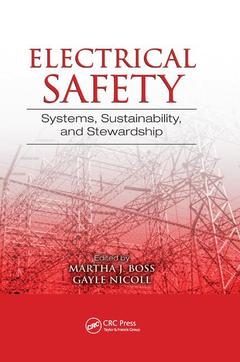Electrical Safety Systems, Sustainability, and Stewardship
Coordonnateurs : Boss Martha J., Nicoll Gayle

Learn How to Implement Safety Codes and Regulations Effectively
A number of electrical fatalities and injuries that occur each year can be overcome by a thorough understanding of electrical concepts. Yet due to the complexity of regulatory requirements, many safety professionals may not be fully equipped to handle the task. Electrical Safety: Systems, Sustainability, and Stewardship addresses the problem by simplifying the knowledge acquisition process, and arming safety professionals with the tools needed to successfully meet safety and efficacy goals. From power generation facility to electrical device, this text combines knowledge of industry standards, regulations, and real-world experience to provide a detailed explanation of electrical power generation, transmittal, and use.
Explains the Concepts behind Electric Code
The book introduces the basic sustainability and stewardship concepts inherent to reliability centered maintenance (RCM). It explains how these concepts apply to the components of an electrical system (the concepts can be used when auditing for electrical safety, training on electrical safety, and overseeing an upgrade or extension of a building's electrical system). In addition, it addresses general electrical safety, electromagnetic field shields, ohm/resistance study criteria, arc flash hazard analysis, and hazardous energy control. The authors outline OSHA requirements and the reasons for those requirements, and explain the implementation exigencies.
This book:
- Describes power generation, transmittal, and usage
- Contains regulatory summaries from the OSHA electrical safety standards
- Presents the various types of electrical studies including arc flash, electromagnetic field, and ohm resistance investigations
- Discusses earthing grounds and overcurrent devices as overall components of electrical control and safety
- Offers an up-to-date discussions of arc flash criteria and evaluation needs that are linked to general electrical safety and grounding requirements
- Considers electromagnetic field physics, measurement, and control alternatives
Electrical Safety: Systems, Sustainability, and Stewardship
Electrical Sustainability and Stewardship. Electrical Components. Transformers. Generators. Circuit Breakers. Relays. Fuses. Substations and Switchyards. Direct Current Utilization. Circuit Disconnects, On/Off Switches, and OSHA. Grounding. Electrical Safety and OSHA. Special Installations and OSHA. Distance Requirements and OSHA. Arc Flash, Personal Protective Equipment, and Classified Locations. Electrical Testing. Electromagnetic Shielded Equipment, Instrumentation, and Facilities, Part One. Electromagnetic Shielded Equipment, Instrumentation, and Facilities, Part Two. Solid-State Technology. Motors. Hazardous Energy Control and OSHA. Glossary. Bibliography. Appendix RCM Evaluation Tables. Index.
Martha J. Boss has led teams in the inspection, analysis, and risk management of electrical safety components, including electromagnetic field (EMF) analyses. Boss earned her BS and BA degrees from the University of Nebraska and the University of Northern Iowa in biology, with a chemistry and physics emphasis. She edited and contributed to Building Vulnerability Assessments, Biological Risk Engineering Handbook, and Air Sampling and Industrial Hygiene Engineering (CRC Press). Martha is also the co-author of Evaluation of Stored Energy Hazards in Underground Coal Mines during and after an Emergency, provided to the National Institute of Occupational Health (NIOSH).
Gayle Nicoll
Date de parution : 06-2017
15.6x23.4 cm
Date de parution : 10-2014
15.6x23.4 cm
Thèmes d’Electrical Safety :
Mots-clés :
Equipment Grounding Conductor; Required Testing Results; Molded Case Circuit Breakers; Electrical Transformer; NFPA 70E; Electrical Transformer LTC; Circuit Breaker; Electrical Transformer Load Tap Changer; IRT; Disconnecting Means; Electrical Safety Inspection; Grounded Conductor; Electrical Safety Audit; Insulation Resistance Test; Health Administration; Proactive Maintenance; Branch Circuit; PT&I; INFRARED THERMOGRAPHY SURVEY; Predictive Testing and Inspection; Solid State Relays; Predictive Maintenance; Fault Current; PM Strategy; Surge Arrester; Preventive Maintenance; Arc Flash; Reactive Maintenance; Energized Parts; RCM; Electromechanical Relays; Reliability Centered Maintenance; Low Voltage Power Circuit Breakers; Electrical Stewardship; Disconnect Switches; Electrical Sustainability; Shielded Enclosure; Electrical Equipment Stewardship; Insulation Resistance; Electrical Equipment Sustainability; Arc Welding; Load Interrupter; GROUND FAULT CIRCUIT INTERRUPTORS; Ground Fault Current; Phase Protection; Voltage Protection; Protective Relaying; Ground Paths; Arc Suppression; Heat Dissipation; Alternate Generator Types; Exciters; PPE; Distance Requirements; Electrical Rectifiers; Current Interrupting Device; Ground-Fault Protection System; Surge Suppression; Circuit Protection; LO/TO; Lock Out/Tag Out; Solid State Technology; EM Shielded Equipment; Jobsite Safety; Workplace Safety; Occupational Safety and Health Agency; Electrical Components; Transformers; Generators; Circuit Breakers; Relays; Fuses; Substations; Switchyards; Direct Current Utilization; Circuit Disconnects; On/Off Switches; OSHA; Grounding; Electrical Safety; Personal Protective Equipment; Electrical Testing; Electromagnetic Shielded Equipment; Hazardous Energy Control


